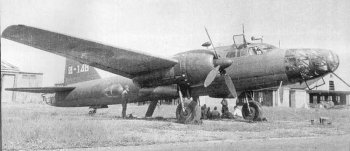![]() The Pacific War Online Encyclopedia
The Pacific War Online Encyclopedia
|
| Previous: Ki-61 "Tony", Japanese Fighter | Table of Contents | Next: Ki-79, Japanese Trainer |

Wikipedia
Commons. Fair use may apply.
Mitsubishi Ki-67-I Hiryu ("Flying Dragon") “Peggy”
|
Crew |
6 to 8 | ||||||||
|
Dimensions |
73’10” by 61’4”
by
18’5” 22.5m by 18.7m by 7.7m |
||||||||
| Wing area | 709
square feet 65.85 square meters |
||||||||
|
Weights |
19,068-30,346 lbs 8,649-13,765 kg |
||||||||
|
Maximum speed |
334 mph 19,980 feet 538 km/h at 6090 meters |
||||||||
|
Climb rate |
25 feet per second 7.6 meters per second |
||||||||
|
Service ceiling |
31,070 feet 9470 meters |
||||||||
| 2 1900 hp (1417 kW) Mitsubishi Ha-104
18-cylinder two-row radial engines driving four-blade constant-speed
propellers. |
|||||||||
|
Armament |
1 20mm Ho-5
cannon in
electric dorsal turret. 4 12.7mm Type 1 machine guns in nose, tail, and two beam positions. |
||||||||
|
Bomb load |
1102 lbs (500 kg) normal 1764 lbs (800 kg) or one torpedo maximum 6393 lbs (2900 kg) as kamikaze |
||||||||
|
Range |
1740 miles (2800 km) normal 2360 miles (3800 km) maximum |
||||||||
| Fuel |
855 gallons 3886 liters |
||||||||
A total of 698 aircraft from 1944-4:
|
|||||||||
| Variants |
The first 160 production aircraft were not
equipped with torpedo racks. The Japanese Army continually requested
additional equipment until 2 December 1943, when the design was frozen
as the Ki-67-I with the specifications shown above. Beginning with the 451st aircraft, a second
12.7mm Type 1 machine gun was added in the tail. The Ki-67-II would have used 2400 hp (1789
kW) Ha-214
engines but neither the engines nor this aircraft variant went into
production. Numerous other experimental models never
went into production. |
||||||||
The Ki-67 Hiryu (Flying Dragon) or Army Type 4 Heavy Bomber was
intended to have the
speed and maneuverability of a fighter.
It was also armored
and had
self-sealing fuel tanks. In many respects it resembled the American B-26 Marauder. It was the best
all-around bomber
produced by Japan. However, material shortages and constant
change requests
delayed its production until 1944, when it was too late to make much
difference in the outcome of the war.
The specification dated to late 1940 and called
for a tactical heavy bomber to replace the Ki-49
Helen. Its expected theater of use at the time was in Manchuria against the Soviet Union. Mitsubishi began design
work in February 1941 under Ozawa. The wings and tails were based on
the G4M1 "Betty", but in most
other respects the design was a radical departure from previous
Japanese military aircraft. The design emphasized ease of production
and included adequate armor protection and self-sealing fuel and oil
tanks. The latter features unfortunately delayed production
significantly. The first prototype flew on 27 December 1942 and
performed well, lacking only very slightly in speed, and had the
maneuverability to perform loops. Production models increased the fuel
capacity and armament.
The Ki-67 first saw operational use in the air
battle off Formosa in October
1944. A number were staged through Iwo
Jima to attack American airfields
in the Marianas, and the
type saw heavy use at Okinawa.
Production was badly impaired thereafter by the American strategic bombing campaign
and the earthquake of December 1944, which badly affected engine
production.
References
The Pacific War Online Encyclopedia © 2007, 2009 by Kent G. Budge. Index